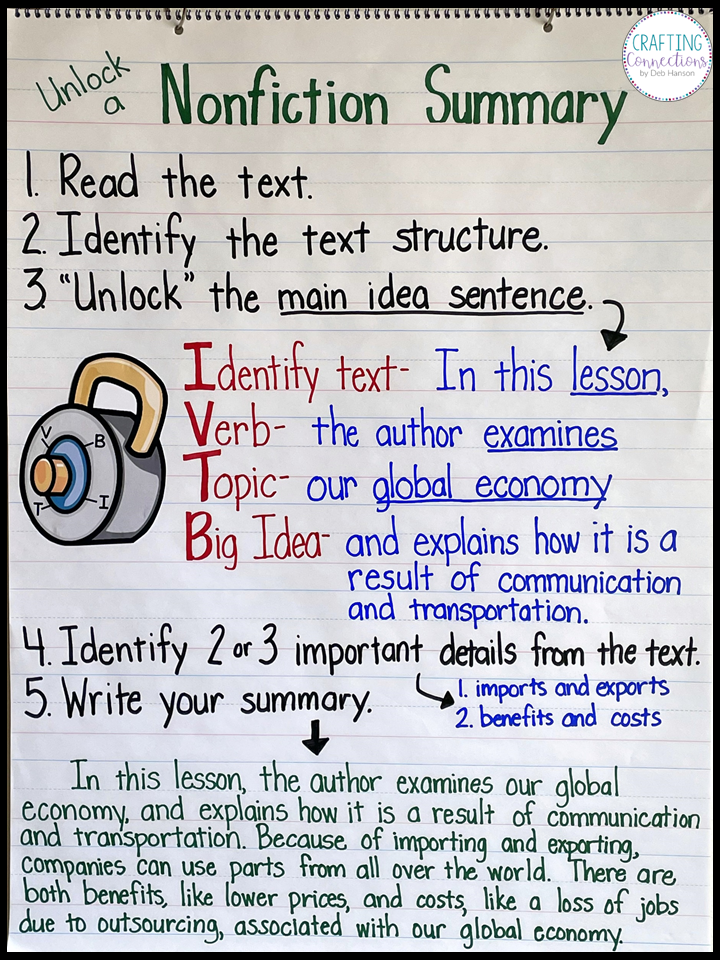Unlocking Reading Comprehension: The Power of Summarizing Anchor Charts for 5th Graders
Remember those colorful charts adorning your elementary school classrooms? They weren't just decorations! These visual aids, known as anchor charts, can be powerful tools in a 5th-grade classroom, especially when it comes to teaching the essential skill of summarizing.
Imagine a fifth grader grappling with a chapter book, struggling to sift through details to find the central message. Enter the summarizing anchor chart – a visual lifeline that guides students through the process of identifying key ideas, ignoring irrelevant information, and crafting a concise retelling.
But what makes these charts so effective? It's all about making the abstract concept of summarizing concrete and accessible. Visual learners benefit from seeing the structure of a good summary, while kinesthetic learners can engage in the process of creating the chart itself. The collaborative nature of developing these charts fosters a shared understanding and encourages active learning.
Anchor charts aren't a new invention. Educators have long recognized the power of visual aids in reinforcing learning. However, their use in supporting specific reading comprehension skills like summarizing has gained traction in recent years, particularly with the increased emphasis on standardized testing and 21st-century learning skills.
A summarizing anchor chart, specifically designed for a 5th-grade level, might include headings like "Main Idea," "Supporting Details," "Key Words," and "Summary Sentence Starters." The chart can evolve throughout a unit of study, with students adding examples, strategies, and even their own creative flourishes.
Advantages and Disadvantages of Summarizing Anchor Charts
Let's delve into the pros and cons of using summarizing anchor charts in a 5th-grade classroom:
| Advantages | Disadvantages |
|---|---|
| Visual and engaging, catering to different learning styles | Can be time-consuming to create, especially collaboratively |
| Provide a clear framework for the summarizing process | Effectiveness depends on teacher modeling and student engagement |
| Promote active learning and student-centered discussions | May not be suitable for all summarizing tasks or texts |
Best Practices for Implementing Summarizing Anchor Charts
To maximize the effectiveness of summarizing anchor charts, consider these best practices:
- Collaborative Creation: Involve students in creating the chart to foster ownership and engagement. Guide them to brainstorm elements, examples, and visuals.
- Clear and Concise Language: Use student-friendly language that aligns with their current understanding of summarizing concepts. Avoid jargon or overly complex terminology.
- Visual Appeal: Incorporate colors, illustrations, and different font sizes to enhance visual appeal and make the chart more memorable.
- Strategic Placement: Display the chart prominently in the classroom where students can easily refer to it during reading and writing activities.
- Ongoing Reference and Revision: Encourage students to revisit the chart regularly. Update and revise it collaboratively as their understanding of summarizing deepens.
Common Questions and Answers about Summarizing Anchor Charts for 5th Grade
Here are some frequently asked questions about using these helpful tools:
Q: When is the best time to introduce a summarizing anchor chart?
A: It's ideal to introduce the chart at the beginning of a unit focusing on summarizing. This allows students to refer to it throughout their learning journey.
Q: How can I differentiate anchor charts for students with varying needs?
A: Consider creating tiered anchor charts with varying levels of support. For instance, one chart could offer more visual cues, while another might include sentence frames for struggling writers.
Q: Can summarizing anchor charts be used with different types of texts?
A: Absolutely! You can adapt the content of the anchor chart to suit different genres, such as fiction, nonfiction, poetry, or even digital texts.
Q: How can I ensure students are actively using the anchor chart?
A: Encourage active engagement by incorporating think-pair-share activities, having students lead mini-lessons on chart elements, or using it as a guide during collaborative summarizing tasks.
Q: What are some creative ways to make summarizing anchor charts more engaging?
A: Incorporate interactive elements like flaps, pockets with key vocabulary cards, or even QR codes linking to video examples or online resources.
Tips and Tricks for Using Summarizing Anchor Charts
Here are some additional tips to make the most of your summarizing anchor charts:
- Laminate your anchor chart to increase durability and allow for multiple uses.
- Take photos of student-created charts to create a digital gallery or class resource folder.
- Encourage students to create individual mini-anchor charts for their reading notebooks to personalize their learning.
In conclusion, summarizing anchor charts are powerful allies in a 5th-grade teacher's toolkit. These visual aids empower students to tackle the challenge of summarizing with greater confidence and skill. By embracing collaborative creation, incorporating visual appeal, and promoting active engagement, educators can harness the potential of these charts to unlock deeper reading comprehension for every learner. As students progress, they'll carry the invaluable skill of summarizing with them, ready to tackle more complex texts and real-world challenges.
Convertir une image png en jpg finding simplicity in image formats
Unlocking insect secrets information found in insect books
Vinyl sauce interior cleaner the secret weapon for a pristine car













